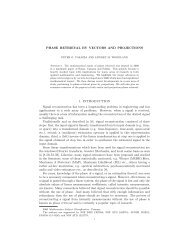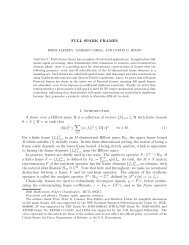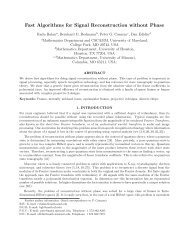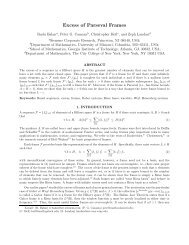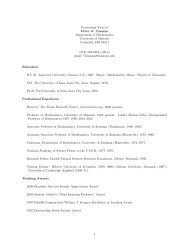Introduction to Finite Frame Theory - Frame Research Center
Introduction to Finite Frame Theory - Frame Research Center
Introduction to Finite Frame Theory - Frame Research Center
You also want an ePaper? Increase the reach of your titles
YUMPU automatically turns print PDFs into web optimized ePapers that Google loves.
<strong>Introduction</strong> <strong>to</strong> <strong>Finite</strong> <strong>Frame</strong> <strong>Theory</strong> 27<br />
Proof. Clearly (i) is equivalent <strong>to</strong> T ∗ ˜T = Id which holds if and only if ˜T ∗ T = Id.<br />
The equivalence of (iii) can be derived in a similar way. ⊓⊔<br />
One might ask what distinguishes the canonical dual frame from the alternate<br />
dual frames besides its explicit formula in terms of the initial frame. Another seemingly<br />
different question is which properties of the coefficient sequence in the decomposition<br />
of some signal x in terms of the frame (see Theorem 8),<br />
x =<br />
M<br />
∑<br />
i=1<br />
〈x,S −1 ϕ i 〉ϕ i ,<br />
uniquely distinguishes it from other coefficient sequences – redundancy allows infinitely<br />
many coefficient sequences. Interestingly, the next result answers both questions<br />
simultaneously by stating that this coefficient sequence has minimal l 2 -norm<br />
among all sequences – in particular those, with respect <strong>to</strong> alternate dual frames –<br />
representing x.<br />
Proposition 16. Let (ϕ i ) M i=1 be a frame for H N with frame opera<strong>to</strong>r S, and let x ∈<br />
H N . If (a i ) M i=1 are scalars such that x = ∑M i=1 a iϕ i , then<br />
M<br />
∑<br />
i=1<br />
|a i | 2 =<br />
M<br />
∑<br />
i=1<br />
|〈x,S −1 ϕ i 〉| 2 +<br />
M<br />
∑<br />
i=1<br />
|a i − 〈x,S −1 ϕ i 〉| 2 .<br />
Proof. Letting T denote the analysis opera<strong>to</strong>r of (ϕ i ) M i=1 , we obtain<br />
Since x = ∑ M i=1 a iϕ i , it follows that<br />
Considering the decomposition<br />
(〈x,S −1 ϕ i 〉) M i=1 = (〈S −1 x,ϕ i 〉) M i=1 ∈ ranT.<br />
(a i − 〈x,S −1 ϕ i 〉) M i=1 ∈ kerT ∗ = (ranT ) ⊥ .<br />
(a i ) M i=1 = (〈x,S −1 ϕ i 〉) M i=1 + (a i − 〈x,S −1 ϕ i 〉) M i=1,<br />
the claim is immediate.<br />
⊓⊔<br />
Corollary 8. Let (ϕ i ) M i=1 be a frame for H N , and let (ψ i ) M i=1 be an associated alternate<br />
dual frame. Then, for all x ∈ H N ,<br />
‖(〈x,S −1 ϕ i 〉) M i=1‖ 2 ≤ ‖(〈x,ψ i 〉) M i=1‖ 2 .<br />
We wish <strong>to</strong> mention that also sequences which are minimal in the l 1 norm play a<br />
crucial role <strong>to</strong> date due <strong>to</strong> the fact that the l 1 norm promotes sparsity. The interested<br />
reader is referred <strong>to</strong> Chapter [162] for further details.



